I received a number of great comments on my last post, Organizing an Agile Marketing team. Several people commented that the organization presumed a large organization, aimed at business to business (B2B) marketing, with long lead times. To that, I plead
guilty.
What if you have only enough resources for a small team? And what if you’re not marketing to businesses, but to consumers? How does that change the organization?
My Taxonomy
For the purpose of this post, I’m going to divide marketers into four groups based on a 2×2 grid: whether you’re marketing to businesses or consumers, and whether the sale takes place offline or online.
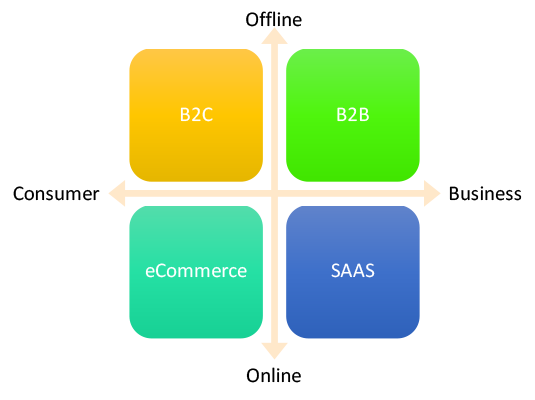
I’m not going to dive down into all the ways that marketing to consumers is different than marketing to businesses, or the differences that selling online versus offline make to marketing. I think these are pretty well established. The names for each quadrant seem fairly settled for me, with the possible exception of SAAS. If someone has a better name for online selling to businesses, let me know in the comments.
I think these are the critical dimensions that impact how your organize the team and the choices you make when you have limited resources.
B2C Marketing
How do you organize a small B2C team for modern, agile marketing? I’m going to assume that you have a leader (a Director or VP of Marketing) and 3 or 4 individuals. Here’s my recommendation:
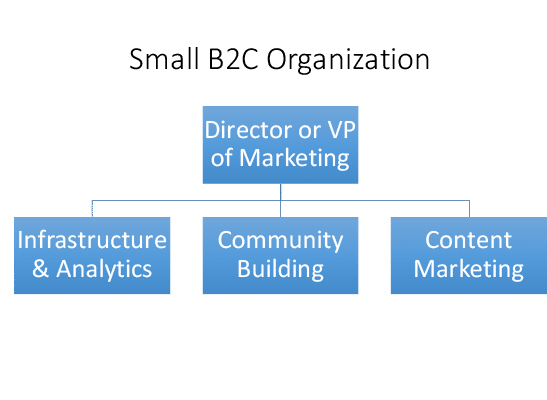
I’m going to stand by my comment in my previous post that the first team should be the infrastructure & analytics team. I realize this may be controversial for B2C marketing, that many B2C companies don’t use CRM or marketing automation systems, but in my opinion, they should. Engage directly with your consumers through email. Analyze your promotional campaigns with analytics. You can’t do these things unless you have the infrastructure and the analytics to experiment, measure and improve.
I go back and forth as to whether community building or content marketing is next in importance. It probably depends on the business. Are you selling something that is expensive and a one-time or infrequent purchase where the buyer needs to be educated (pools, RVs)? Start with content marketing to educate your buyer. Are you selling inexpensive, repeat purchase items (cupcakes, coffee)? Start with community building. Both are important. The coffee house has an opportunity to educate the consumer about coffee through content marketing.
Someone is probably going to ask me where social media is in the organization and why it’s not a separate group? I think social media is a tool, and perhaps one of the most important tools of the community building group. But I’d rather not say to that group, your mission is social media. The mission of that group is to build community – whether they do that through social media, events, email or whatever means, the focus is on the mission not the tool.
B2B Marketing
I’ve spent most of my career in B2B marketing. My emphasis here is on modern, agile marketing, not a traditional B2B marketing organization. Here’s how I would organize a small B2B team:
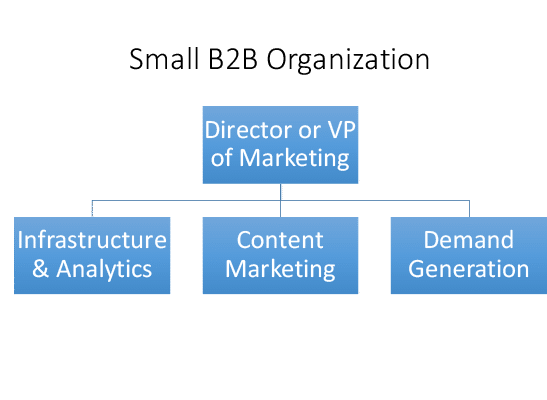
Again, I’m going to begin with the infrastructure & analytics group. Next, I’m going to add a content marketing specialist, to feed the web site, the sales force and the demand generation activities. And lastly, I’m going to task someone with generating leads, whether that be through inside sales warm/cold calling, webinars, email campaigns or whatever. If I have a 4th person, I’m probably going to devote them to Remarkable Customer Experiences or product management.
eCommerce Marketing
I’m not talking about Amazon here, but about small eCommerce companies. Someone large enough to have a separate marketing team, but small enough that the team is 4 or 5 people. Here’s how I’d organize that team:
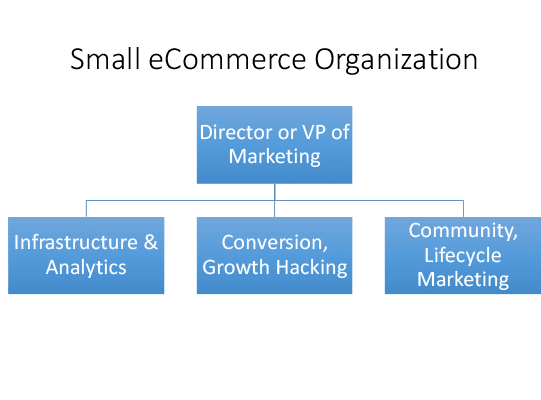
Again, start with infrastructure & analytics, with a particular emphasis on measuring conversions. Second, you need a team that really understands how to do A/B testing, generate conversions and generate fast growth, better known as growth hacking. They need to make sure those shopping carts get full and they check out. The third group is responsible for repeat purchases, and for identifying community functions that contribute to sales. Generating reviews is the most obvious example of this. But you also want to build a community of raving fans, who will buy more and attract more fans.
SAAS Marketing
If you’re a SAAS marketer, I’d highly recommend that you read The Nine Disciplines of Great SAAS Companies. After that, if you don’t have enough people to staff all those functions, here is my recommendation about where to start:
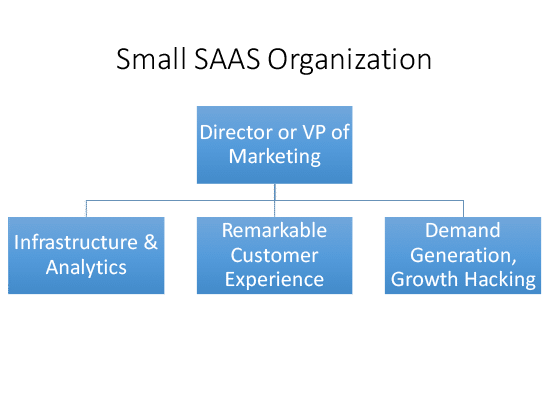
By now, you won’t be surprised that I think you should start with your infrastructure and analytics team. You need marketing automation, and you need to be able to measure your experiments. But the second part of the organization that I think you should staff for may be a surprise: the remarkable customer experience or product management team. I think this is critical for SAAS companies to get right. If the experience is remarkable, you’ll get your evangelists, you’ll get repeat business, and some level of demand generation will happen on its own. If you don’t get this right, your demand generation group will just be spreading bad experiences with your product or service.
I went back and forth as to whether the demand generation team should be staffed next or the content marketing, but ultimately I chose demand generation. You can outsource your content marketing if necessary. You can’t outsource your demand generation. This is the next most important thing to get right, and will basically determine if you succeed or fail. This is one of the most important hires in the company, equivalent to hiring the VP of Sales in a traditional B2B company.
So those are my thoughts about organizing smaller teams. What do you think? How is your agile marketing team organized?

